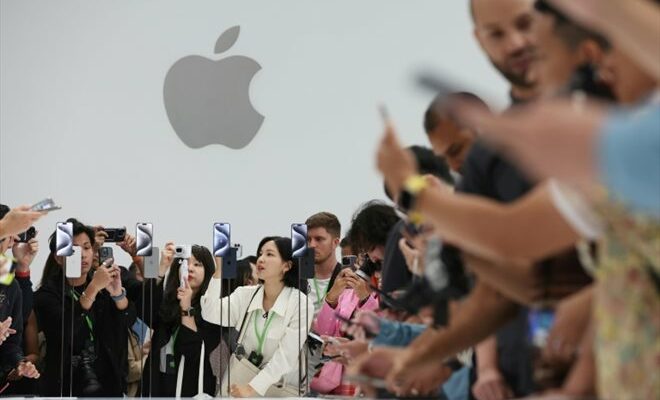An event organized by Apple in Cupertino (California), United States, September 12, 2023 (GETTY IMAGES NORTH AMERICA/AFP/Archives/JUSTIN SULLIVAN)
The week promises to be crucial for Apple, which must present, during its annual conference in California intended for developers, its new products integrating generative artificial intelligence (AI) and try to make up part of the delay accumulated over its major competitors.
A year and a half after the launch of ChatGPT, the OpenAI interface, in November 2022, the Apple brand appears, in the eyes of the public and Wall Street, behind Microsoft, Google, Amazon or Meta, which cover their generative AI communication.
If artificial intelligence has already been very present in its iPhone, iPad or Mac for many years, Apple has not made any specific announcement so far.
“The company has always been obsessed with what its products brought to its customers” and “not by the miracles of digitalization and miniaturization,” recalls Dipanjan Chatterjee, analyst at Forrester. “That’s why Apple was loath to talk about the core technology that powered its devices.”
But amid the post-ChatGPT uproar, Apple’s “silence” “has become deafening,” he adds.
Obsessed with generative AI, investors have heckled Apple shares, which have gained only 2.5% since the start of the year, compared to 13% for Microsoft, 21% for Amazon or 25% for Alphabet ( Google).
Therefore, the annual developer conference (WWDC), which is held from Monday to Friday, “represents the most important event for Apple in a decade with, in the background, the pressure to present to developers and consumers a package of generative AI,” says Dan Ives, analyst at Wedbush Securities.
Angelo Zino, from CFRA, expects, like many others, that the Apple firm will unveil a new version of its iOS operating system, the 18th, boosted with artificial intelligence.
According to several American media, Apple has previously established a partnership with OpenAI, which will allow it to use the start-up’s language models, these gigantic databases making it possible to answer a question asked in everyday language.
– Siri resurrected? –
“This should make Siri much smarter, with the ability to chat and decline AI across the Apple ecosystem, photo editing, searching on Safari (the search engine), notes, emails or even emojis,” anticipates Angelo Zino.
Launched more than 12 years ago, Siri is today a “strangely unhelpful aid”, believes Dipanjan Chatterjee, surpassed, in its current version, by the new generation of assistants powered by generative AI, such as GPT -4o, presented in mid-May by OpenAI.
A partnership between Apple and OpenAI “could do the same wonders for the languishing Siri,” according to the analyst.
For Carolina Milanesi, analyst at Creative Strategies, these improvements and new features should help to strengthen the attractiveness of the brand’s products.
“The goal for Apple is to get people to replace their iPhone,” insists the analyst. “We will see if Apple gives them sufficient reasons to do so.”
“The moment is crucial for Apple,” insists Gadjo Sevilla, analyst at Emarketer, for whom the WWDC communication is a “litmus test” of the Cupertino (California) group’s ability to monetize generative AI as has already been known. do it Google and especially Microsoft.
– Quest for new successes –
This new challenge comes as Apple tries to reconnect with its legend, that of a company accustomed to launching products and services likely to cause a break in consumption habits, from the Macintosh to the iPhone, including the ‘iPod.
It made a first significant shift in February with the presentation of its “mixed” (virtual and augmented) reality headset “Vision Pro”.
It is nevertheless, in its current version, a high-end product ($3,499 per unit), which is only aimed at a restricted part of Apple’s traditional audience.
In addition to the lead taken by its competitors, this quest for new successes is made more urgent for Apple by the decline in iPhone sales, which fell by 10% year-on-year in the first quarter of 2024.
With generative AI, the technology group is investing, in addition to the devices themselves, in its services activity, which has become the lifeblood of Apple’s growth.
According to Canalys, 16% of smartphones delivered this year will be equipped with generative AI features, a proportion that it expects to rise to 54% in 2028.
© 2024 AFP
Did you like this article ? Share it with your friends using the buttons below.




